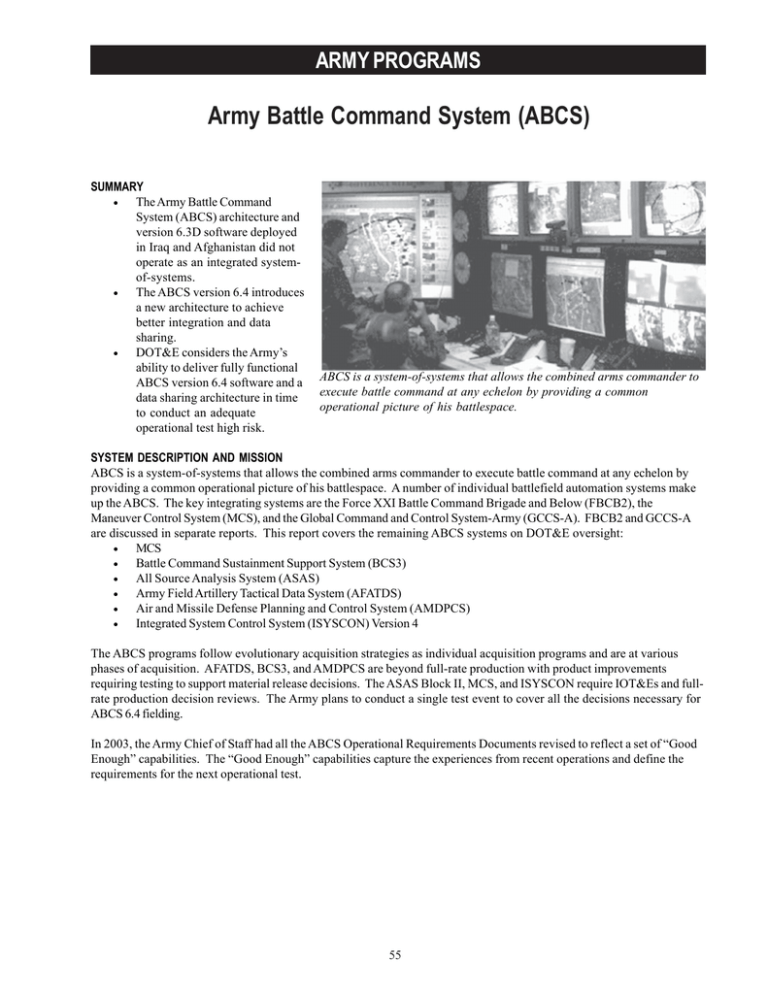Army Battle Command System (ABCS) ARMY PROGRAMS
advertisement

ARMY PROGRAMS Army Battle Command System (ABCS) SUMMARY • The Army Battle Command System (ABCS) architecture and version 6.3D software deployed in Iraq and Afghanistan did not operate as an integrated systemof-systems. • The ABCS version 6.4 introduces a new architecture to achieve better integration and data sharing. • DOT&E considers the Army’s ability to deliver fully functional ABCS version 6.4 software and a data sharing architecture in time to conduct an adequate operational test high risk. ABCS is a system-of-systems that allows the combined arms commander to execute battle command at any echelon by providing a common operational picture of his battlespace. SYSTEM DESCRIPTION AND MISSION ABCS is a system-of-systems that allows the combined arms commander to execute battle command at any echelon by providing a common operational picture of his battlespace. A number of individual battlefield automation systems make up the ABCS. The key integrating systems are the Force XXI Battle Command Brigade and Below (FBCB2), the Maneuver Control System (MCS), and the Global Command and Control System-Army (GCCS-A). FBCB2 and GCCS-A are discussed in separate reports. This report covers the remaining ABCS systems on DOT&E oversight: • MCS • Battle Command Sustainment Support System (BCS3) • All Source Analysis System (ASAS) • Army Field Artillery Tactical Data System (AFATDS) • Air and Missile Defense Planning and Control System (AMDPCS) • Integrated System Control System (ISYSCON) Version 4 The ABCS programs follow evolutionary acquisition strategies as individual acquisition programs and are at various phases of acquisition. AFATDS, BCS3, and AMDPCS are beyond full-rate production with product improvements requiring testing to support material release decisions. The ASAS Block II, MCS, and ISYSCON require IOT&Es and fullrate production decision reviews. The Army plans to conduct a single test event to cover all the decisions necessary for ABCS 6.4 fielding. In 2003, the Army Chief of Staff had all the ABCS Operational Requirements Documents revised to reflect a set of “Good Enough” capabilities. The “Good Enough” capabilities capture the experiences from recent operations and define the requirements for the next operational test. 55 ARMY PROGRAMS TEST AND EVALUATION ACTIVITY The Army Test and Evaluation Command conducted a system assessment of the ABCS Version 6.3D architecture supporting operations in Afghanistan and Iraq. The assessment team visited units deployed in theater to observe operations, interview users, and document system utility. The assessment, published in March 2004, reinforced the Army Chief of Staff review. In response to the “Good Enough” review and the ABCS Version 6.3D assessment, the Program Executive Office developed the ABCS Version 6.4 architecture. Each of the ABCS program offices delivered the ABCS Version 6.4 software for their system to the Central Technical Support Facility at Fort Hood, Texas, for integration and testing in April 2004 as scheduled. Upon completion of integration testing, the system will begin Intra-Army Interoperability Certification Testing in October 2004 (postponed from July 2004). AFATDS is the only system to conduct a separate test event this past year. A Limited User Test (LUT) in July 2004 examined capabilities specific to field artillery operations. The AFATDS test strategy requires the LUT and the ABCS event to support the AFATDS 6.4 material release decision. The ABCS Test and Evaluation Integrated Product Team continues planning for the combined ABCS test event now scheduled for March 2005. This combined event will provide the venue to complete required operational testing and support decision reviews for the various ABCS components. TEST AND EVALUATION ASSESSMENT The ABCS architecture deployed in Iraq and Afghanistan did not operate as an integrated system-of-systems and did not provide the shared situational awareness described in the operational requirements documents. However, the separate ABCS components did provide individual capabilities and digital tools to support the commander. Various factors affected the integration of these components to include the communications architecture, training, and user/system interfaces. 56 ARMY PROGRAMS The ABCS Version 6.4 introduces a new architecture to achieve the desired integration. This new architecture embodies the network centric concepts outlined by the Department of Defense and present in upgrades to the Global Information Grid. However, the schedule does not include sufficient time for technical integration and operational training. The ABCS Version 6.4 has been experiencing technical and integration challenges – delaying interoperability certification testing from July to October 2004. The delays increase the risk to the operational test event in March 2005. Available resources also hamper planning for the ABCS operational test event, primarily the test unit (4th Infantry Division). The unit has competing priorities including unit modularization/restructuring, equipment modernization, and training for deployment - further complicating the ability to conduct an adequate test. Based on these factors, DOT&E considers the ability to deliver a fully functional ABCS Version 6.4 architecture to deploying units and conduct an adequate operational test to support the many separate acquisition decisions high risk. 57 ARMY PROGRAMS 58







